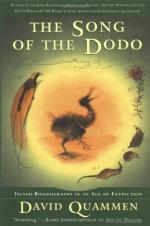
|
| Name: _________________________ | Period: ___________________ |
This test consists of 15 multiple choice questions and 5 short answer questions.
Multiple Choice Questions
1. What does Quammen say Wallace developed in South America?
(a) A clear vision of the profits to be made in providing scientists with specimens.
(b) A deep devotion to the science of zoology.
(c) A sharp eye for different traits in insects.
(d) A terrifying vision of the destruction of ecosystems.
2. What was Carl Jones trying to rescue in Mauritius?
(a) A crab.
(b) A macaque.
(c) A kestrel.
(d) A komodo dragon.
3. What literary term describes Quammen's use of the image of the Persian rug?
(a) Personification.
(b) Symbolism.
(c) Metaphor.
(d) Simile.
4. What does Quammen interject into his historical narrative about ecosystem studies?
(a) Sociological insights.
(b) Jokes.
(c) Personal stories.
(d) Apocalyptic visions.
5. When did Krakatau erupt?
(a) 1721.
(b) 1883.
(c) 1923.
(d) 1852.
6. What was the special creation theory?
(a) The idea that God made each species for its environment.
(b) The theory that man was specifically created out of the best traits of the other animals.
(c) The theory that the universe was created especially for man's comfort.
(d) The theory that species developed only the most aesthetic traits.
7. What did Frank Preston say made up the majority of species in any ecosystem?
(a) A few very common species.
(b) A few very rare species.
(c) A large number of small animals that served as food for a number of larger animals.
(d) A large number of fairly common species.
8. What was Tasmania's environmental history, according to Quammen?
(a) It was separated from Australia by water.
(b) It experienced a catastrophic eruption that killed off everything on the island, before life returned slowly.
(c) It was isolated by a growing mountain range in India.
(d) It was formed by a volcano in the sea.
9. When does Quammen say his field became a field of inquiry?
(a) With Quammen.
(b) With MacArthur and Wilson.
(c) With Darwin.
(d) With Alfred Wallace.
10. Who does Quammen say typically collected insects?
(a) Wealthy Brits.
(b) Hunters in the Amazon.
(c) Ambitious young Americans.
(d) The most devoted scientists.
11. Where did the dodo live?
(a) Sri Lanka.
(b) Galapagos Islands.
(c) Mauritius.
(d) Madagascar.
12. Who did Robert Bates work with?
(a) Wilson.
(b) Quammen.
(c) Darwin.
(d) Wallace.
13. What is the term that encompasses David Quammen's overall idea?
(a) Island biogeography.
(b) Functional adaptation.
(c) Ecosystem collapse.
(d) Survival of the fittest.
14. What is a thylacine?
(a) A crab.
(b) A kangaroo.
(c) A Tasmanian tiger.
(d) A kestrel.
15. What surprising dispersal ability does Quammen say elephants have?
(a) Ability to swim long distances.
(b) Ability to go without water for weeks.
(c) Ability to be carried in other animals' fur.
(d) Ability to be carried on wind currents.
Short Answer Questions
1. What were Frank Preston's findings in plotting the distribution of species in island habitats?
2. What kinds of animals did Philip Darlington look at?
3. What does Quammen say an island is?
4. When did the dodo go extinct?
5. What is the literary term that describes Quammen's addressing the reader directly?
|
This section contains 499 words (approx. 2 pages at 300 words per page) |

|




